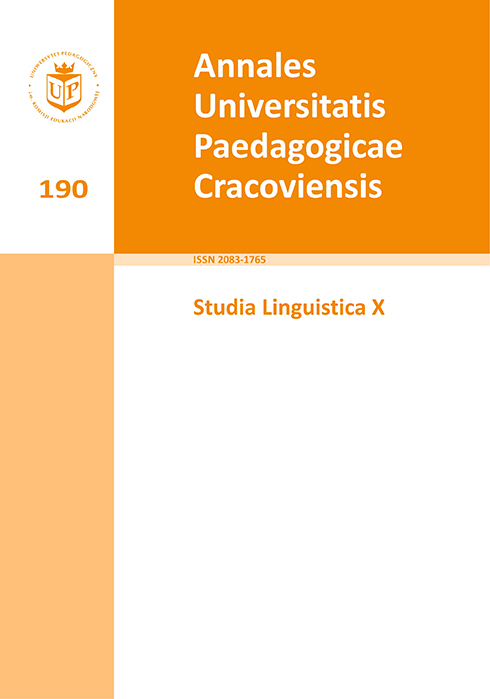Способи семантичної деривації в українській релігійній лексиці
Main Article Content
Abstrakt
We came to the conclusion that narrowing of meaning and metonymy are two main types of semantic derivation of all thematic fields of religious vocabulary (52% and 42%, respectively). Metaphor (6%) as a form of semantic derivation and an empirical classifier of the objects of observation is counterproductive in the religious sphere, since for the religious vocabulary empiricalness is not the main source of spiritual knowledge. Active narrowing of well-known and specialized meanings is the result of linguistic conservatism, the emergence of new functions of objects and changes in the knowledge about them. The disappearance of many of the primary meanings was induced by sustainable consolidation of religious narrowings, and frequent replacement of considerable part of them with synonymic equivalents made their functioning to be just a temporal phenomenon. Metonymy in the religious vocabulary as an effective means to achieve economy of speakers’ efforts is well-developed by local, temporal, causal, attributive and synecdochic types. Metaphors created directly by individuals in their religious activities and those from the Bible that underwent terminologization were created in different ways, namely according to the similarity of features (such as function, external feature, relation of subordination, unreal [but desirable] feature, associative characteristics of emotive evaluative nature).
Downloads
Article Details
Autor, zgłaszając tekst do redakcji czasopisma „Annales Universitatis Paedagogicae Cracoviensis. Studia Linguistica”, zaświadcza, iż jest on rezultatem wyłącznie jego własnej twórczości, że treść artykułu nie była dotychczas publikowana oraz że utwór nie narusza w żadnym stopniu praw autorskich ani praw pokrewnych innych osób, jak również innych praw osób trzecich, a także, że niczyje prawa do utworu (lub jego jakiejkolwiek części) nie zostały pominięte. Po podpisaniu umowy prawa majątkowe do opublikowanych materiałów zostają przeniesione na Wydawnictwo Naukowe Uniwersytetu Komisji Edukacji Narodowej w Krakowie.
Rocznik „Annales Universitatis Paedagogicae Cracoviensis. Studia Linguistica” to czasopismo o otwartym dostępie, a cała jego zawartość jest udostępniana bezpłatnie dla użytkowników i instytucji na zasadach licencji Creative Commons CC-BY-NC-ND 4.0 (uznanie autorstwa, użycie niekomercyjne, bez utworów zależnych). Na podstawie tej licencji autorzy zgadzają się, że ich prace mogą być zgodnie z prawem ponownie wykorzystywane do jakichkolwiek celów, za wyjątkiem celów komercyjnych, bez konieczności uzyskania uprzedniej zgody ze strony autora lub wydawcy. Każdy może prace te czytać, pobierać, kopiować, drukować, rozpowszechniać oraz przetwarzać, pod warunkiem poprawnego oznaczenia autorstwa oraz oryginalnego miejsca publikacji. Publikowanych tekstów nie można wykorzystywać do tworzenia utworów zależnych (np. do tłumaczenia ich i publikowania w innym języku bez zgody wydawcy). Jest to zgodne z definicją otwartego dostępu BOAI (Budapest Open Access Initiative) „Studia Linguistica”nie pobiera opłat za składanie artykułów ani ich przetwarzanie.
Autor, przesyłając artykuł do redakcji „Studia Linguistica”, bezwględnie zgadza się z poniższymi punktami:
-
Oświadczam, że jestem Autorem lub Współautorem nadesłanego tekstu. Przesłany tekst nie był nigdzie publikowany, jest całkowicie oryginalny i nie narusza w żadnym stopniu praw autorskich ani praw pokrewnych innych osób, jak również innych praw osób trzecich, a także, że niczyje prawa do utwory nie zostały pominięte.
-
Oświadczam, że nadesłany tekst nie został złożony do recenzji lub/i publikacji w innym czasopiśmie.
-
Przyjmuję do wiadomości, że Autor ponosi pełną odpowiedzialność za każdy przypadek plagiatu, niezależnie od tego, czy został on wykryty podczas procesu recenzji, czy po publikacji w „Studia Linguistica”.
-
Oświadczam, że ponoszę pełną odpowiedzialność finansową i prawną za wszelkie roszczenia związane z utworem.
-
Potwierdzam uznanie wszystkich źródeł danych wykorzystanych i cytowanych w badaniach.
-
Potwierdzam, że artykuł został wykonany z należytą starannością zgodnie ze standardami edytorskimi „Studia Linguistica”.
Bibliografia
Арутюнова Н. Д., 1988, Типы языковых значений, Москва.
Google Scholar
Балалыкина Э. Г., 1993, Приключения слов, Казань.
Google Scholar
Bartmiński J., 2009, Językowe podstawy obrazu świata, Lublin.
Google Scholar
Бібла С., 2001, Склад, джерела і шляхи формування української церковної термінології (назви церковних чинів та посад), Київ.
Google Scholar
Гак В. Г., 1998, Языковые преобразования, Москва.
Google Scholar
Зализняк А., 2006, Многозначность в языке и способы ее представления, Москва.
Google Scholar
Львов А. С., 1975, Лексика „Повести временных лет”, Москва.
Google Scholar
Никитин М. В., 1996, Курс лингвистической семантики, Санкт-Петербург.
Google Scholar
Осінчук Ю., 2009, Історія української богослужбово-обрядової лексики, Київ.
Google Scholar
Падучева Е., 2004, Динамические модели в семантике лексики, Москва.
Google Scholar
Пауль Г., 1960, Принципы истории языка, Москва.
Google Scholar
Піддубна Н., 2000, Формування номенклатури назв релігійних споруд в українській мові, автореферат, Харків.
Google Scholar
Пуряєва Н., 2001, Формування української церковно-обрядової термінології (назви богослужбових предметів), автореферат, Київ.
Google Scholar
Silva М., 1983, Biblіcal Words and Their Meanings, Michigan.
Google Scholar
Тараненко О. О., 1980, Полісемічний паралелізм і явище семантичної аналогії, Київ.
Google Scholar
Ульман С., 1970, Семантические универсалии, [в:] Новое в лингвистике, вып. 5, с. 250–199.
Google Scholar
Шевченко Л., 2001, Семантична трансформація слів у текстах Нового Заповіту, [в:] Мовознавство, No3, с. 70–75.
Google Scholar

